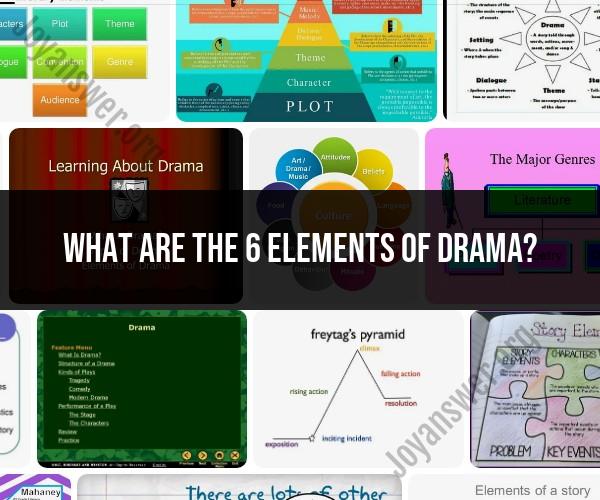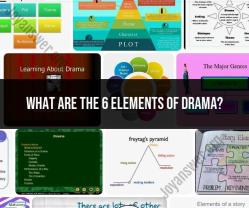What are the 6 elements of drama?
The six elements of drama, also known as the "Six Aristotelian Elements," are key components that make up a dramatic work. These elements help define and analyze the structure and content of a play, screenplay, or theatrical performance. The six elements of drama are as follows:
Plot: The plot is the sequence of events that make up the story. It includes the exposition (introduction of characters and setting), rising action (the development of the central conflict), climax (the turning point of the story), falling action (events that follow the climax), and resolution (the conclusion or outcome).
Character: Characters are the individuals who participate in the story. They have distinct personalities, motivations, and roles within the narrative. Characters can be protagonists (main characters), antagonists (opposing characters), or supporting characters.
Theme: The theme is the central idea or message of the dramatic work. It represents the underlying concepts, moral lessons, or social commentary that the story conveys. Themes can vary widely and may address universal human experiences, societal issues, or individual struggles.
Dialogue: Dialogue refers to the spoken interactions and conversations between characters. It plays a crucial role in advancing the plot, revealing character traits, and conveying information to the audience. Effective dialogue is often characterized by naturalness, subtext, and relevance to the story.
Music and Sound: Music and sound effects contribute to the atmosphere and emotional impact of a dramatic work. These elements can create mood, build tension, emphasize key moments, and enhance the overall sensory experience for the audience.
Spectacle: Spectacle encompasses the visual and sensory aspects of a performance. This element includes elements like set design, costumes, lighting, special effects, and staging. Spectacle enhances the aesthetic and immersive qualities of a dramatic production.
These six elements of drama provide a framework for understanding and analyzing the components of a dramatic work. Playwrights, directors, actors, and audiences all engage with these elements to create, interpret, and appreciate theatrical performances. While these elements are foundational, it's important to note that the interpretation and execution of drama can vary widely, resulting in a rich diversity of theatrical experiences and styles.
Elements of Drama: The Core Building Blocks of Theater
The elements of drama are the essential components that make up a theatrical performance. They are the building blocks that allow playwrights, directors, actors, and other theater professionals to tell stories on stage.
The six elements of drama are:
- Plot: The sequence of events that takes place in the play.
- Character: The people who populate the play and drive the plot forward.
- Theme: The central message or idea that the play explores.
- Dialogue: The words that the characters speak to each other.
- Music: The use of sound and melody to enhance the performance.
- Spectacle: The visual elements of the play, such as the costumes, sets, and lighting.
These six elements are all interrelated, and they work together to create a cohesive and engaging theatrical experience.
The Art of Storytelling: Six Essential Elements of Drama
The elements of drama are essential for storytelling, as they allow playwrights to create characters that audiences can relate to, plots that are both suspenseful and meaningful, and themes that resonate with our deepest emotions.
Dramatic Ingredients: A Closer Look at the Six Elements of Theater
Here is a closer look at each of the six elements of drama:
- Plot: The plot is the sequence of events that takes place in the play. It is the story that the playwright is trying to tell. The plot is typically divided into five parts: exposition, rising action, climax, falling action, and resolution.
- Character: The characters are the people who populate the play and drive the plot forward. Playwrights develop characters by giving them unique personalities, motivations, and goals.
- Theme: The theme is the central message or idea that the play explores. Themes can be universal or specific, and they can be explored in a variety of ways.
- Dialogue: The dialogue is the words that the characters speak to each other. It is through dialogue that the characters reveal their personalities, motivations, and goals.
- Music: Music can be used to enhance the performance in a variety of ways. It can be used to create atmosphere, to emphasize key moments in the plot, or to express the emotions of the characters.
- Spectacle: The spectacle is the visual elements of the play, such as the costumes, sets, and lighting. The spectacle can help to create a sense of time and place, and it can also be used to create a mood or atmosphere.
By understanding and using the elements of drama, playwrights can create theatrical experiences that are both entertaining and thought-provoking.


